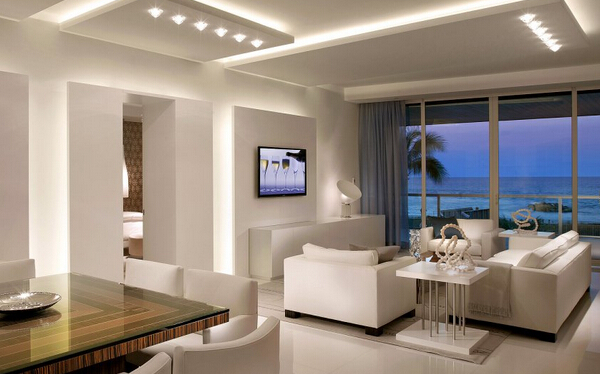Our Right to Good Light
“On behalf of Bridgelux, I would like to express disappointment in the recent Department of Energy rollback of requirements for energy-efficient bulbs. It is a shame that the U.S. has led in the development of LED technology, but has lagged behind much of the rest of the world in its beneficial deployment. We at Bridgelux remain committed to advancing technology that will deliver increased energy savings for our customers and decreased environmental impact."
–Tim Lester, Bridgelux CEO
Background
The United States Department of Energy recently decided to roll back a decision implemented under President George W. Bush, and later finalized under President Obama, that would increase lighting efficiency requirements for certain bulbs while phasing out incandescent and halogen bulbs come 2020.
Efficiency standards created to both protect the environment and deliver quality lighting products with significant lifespans and energy savings have essentially been ripped from our hands. This rollback is not just a rollback of policy. It is a rollback of environmental protection, of potential consumer cost savings and of our industry being able to have a positive impact on the lives of consumers. This decision has ramifications for consumers and the environment that we must explore and understand.
LEDs are a better option for the consumer and the environment but the requirement to phase out incandescent and halogen bulbs is needed because a few large companies have cornered the incandescent and halogen market, and profit from impeding the conversion to LED technology. These companies have long lobbied the government to establish barriers and stifle the advancement needed for the greater good.
Why Should You Care?
Three E’s: Energy, Environment and Efficiency
"LEDs have less negative environmental impacts than incandescent bulbs and a slight edge over CFLs”
– United States Department of Energy
LED lighting technology is almost synonymous with energy, environmental and efficiency savings today. We’ve all heard the claim that using LED lightbulbs can help reduce the need for existing nuclear reactors or electrical power plants. Although this story has been around for some time, the trend remains: LEDs consume less power, which ultimately reduces greenhouse emissions from power plants. Carbon dioxide emissions are lower for LEDs, and the heat generated during use are less than incandescent bulbs.
According to Bloomberg, “The standards, which had been scheduled to take effect in January 2020, applied to roughly half of the six billion light bulbs in use today, and would save consumers billions of dollars in energy costs and avoid millions of tons in carbon dioxide emissions, according to environmental groups backing the rules.” We believe this rollback can have measurable, negative impact on the environment in the long run.
Cost of Ownership
When LEDs first entered the market, they were, admittedly, more expensive than the average consumer bulb. However, as more and more companies entered the lighting market, the cost of LED bulbs has decreased and the broader accessibility to more consumers has increased.
Again by its own admission, the Department of Energy has stated that “LEDs use 25%–30% of the energy and last 8 to 25 times longer than halogen incandescents…While LEDs are more expensive, they still save money because they last a long time and have very low energy use.”
LEDs last a long time and have minimal hazardous materials that hurt the environment when they are disposed. CFLs use mercury vapor to transport electrical currents through the light bulb. Even though the amount of mercury is relatively small, CFLs must still be disposed of as hazardous waste. Mercury is a toxic heavy metal that can cause severe damage to the brain, nervous system, kidneys, lungs, and other vital organs. Disposing of hazardous waste is costly and inconvenient, causing most CFLs to be improperly disposed with a resulting negative impact on the environment.
With this rollback, consumers will have the option to continue purchasing lightbulbs made with legacy technology that may cost less, but they will also deliver inferior quality and shorter lifespans. The rollback may seem like an immediate cost savings, but consumers will end up paying more in the long run for utilities and replacement bulbs.
Technology Advances and the Right to Good Light
"Lighting based around human perception and health is a human right, not a privilege...We want our high-quality systems to be easily adopted and affordable to everyone."
– Dr. Brian Cumpston, Bridgelux Vice President of Solutions Development
When it comes to health and wellbeing, “human centric lighting” isn’t just a buzzphrase anymore. Lighting can and will affect your wellbeing, and many companies on our industry are working hard to ensure that the qualities of LED light are safe, helpful and pleasant.
Dynamic, tunable LED lighting offers variations in color and intensity of light for it be catered to the needs of a particular environment. If a school needs its students to be awake during a test, the light can be adjusted to deliver more blue content. If a hospital needs patients to rest and not be too disturbed if they need to get up during the night, the light can be adjusted to deliver more amber content.
According to a post from The American Institute of Architects, “LED bulbs provide an array of health benefits. This is largely due to the fact that LED light more closely mirrors the spectral wave of natural daylight, whereas fluorescent lights emit large spikes in color that is disorienting to the brain.”
By removing the policy for more efficient lighting, the Department of Energy’s rollback can hurt people. Propagating less efficient, less advanced bulbs in classrooms, hospitals and homes will affect nearly all of us. Many of us in the lighting industry are working on ways to improve spectra, to avoid physiological damage, and increase positive moods and experiences despite the consequences of this policy that will de-incentivize these technology advancements.
What’s Next
We believe that with the cost of LED bulbs decreasing, and with many reputable lighting companies serving this market, consumer have a variety of better choices today - in both quality and cost - when it comes to lighting their indoor and outdoor spaces. By choosing LEDs, consumers can reduce some of their energy expenses in the long term and feel confident in knowing that they are helping the environment.
We will await the full implications of this latest policy change, and are interested to see what may come from the public meeting scheduled for October. In the meantime, we are more committed and determined than ever to continue developing and delivering advanced LED lighting solutions for the general illumination market.
Please feel free to leave us your feedback and thoughts in the comments below.


